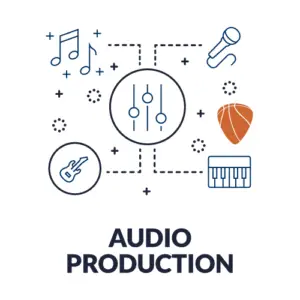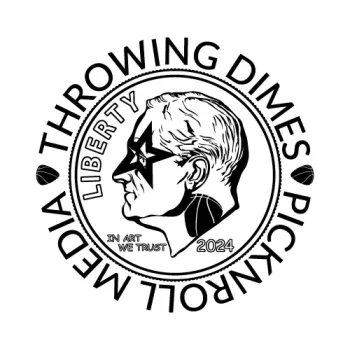
How To Record Guitar Through A Stereo Mic'd Amp
Check Out This Trick For Dialing In Your Mic Placement!
rotating mic rig shopping list:
Advantages of Mic’d Amp Recording:
Authentic Tone & Feel – A mic’d amp captures the full character of your amplifier, speaker, and even the room it’s in, resulting in a more natural and dynamic sound.
Better Response to Playing Dynamics – Real amps interact differently depending on how you pick or strum, whereas some plugins can feel slightly compressed or artificial.
Unique Sound Signature – The combination of your amp, mic placement, and recording space gives you a one-of-a-kind sound that’s hard to replicate with software.
Organic Interaction with Effects – Analog pedals and the way they interact with an actual amp (especially with tube saturation) often sound richer and more nuanced than digital recreations.
No Latency Issues – Unlike plugins, which can introduce latency depending on your interface and buffer size, mic’d amps have no digital processing delay.
Advantages of Using Software Plugins:
Convenience & Flexibility – You can record at any time without worrying about noise levels, and you can switch amp models and settings after recording.
Cost-Effective – A good amp, mics, and an acoustically treated space can get expensive, whereas plugins like Neural DSP, AmpliTube, or Helix Native offer a wide range of tones at a fraction of the cost.
Easy Experimentation – You can try different amp and cab models instantly, rather than being locked into the sound of a specific amp.
Consistent Results – Mic placement and room acoustics can greatly affect a mic’d amp recording, whereas plugins give you a controlled and repeatable tone.
Portability – No need to lug around amps and mics—just plug in your interface, load up your plugin, and you’re good to go.
Which One Should You Use?
If you’re after authentic, organic tones and you have the space, gear, and patience for mic placement, a real amp can be the best choice.
If you need flexibility, affordability, and ease of use, plugins are fantastic and have gotten incredibly realistic in recent years.
A great compromise is reamping—recording a clean DI track and then sending it through a real amp later, allowing you to get both the convenience of plugins and the authenticity of a real amp.
Dynamic Microphone or Condenser Microphone?
Dynamic and condenser microphones are the two most common types of microphones used for recording vocals and instruments, and they each have distinct characteristics that make them suitable for different applications.
1. Key Differences in Design and Functionality
Dynamic Microphones:
Use a diaphragm attached to a coil of wire, which moves within a magnetic field to generate an electrical signal.
More rugged and durable.
Do not require external power (phantom power).
Less sensitive to subtle sound details but handle high sound pressure levels (SPL) well.
Condenser Microphones:
Use a diaphragm that is part of a capacitor, requiring external power (phantom power or a battery) to operate.
More sensitive to sound and capture a wider frequency range.
Less durable than dynamic mics and can be affected by humidity and physical shock.
Typically provide more detailed and nuanced recordings.
2. Recording Vocals
Dynamic Microphones for Vocals:
Best for live performances and aggressive vocal styles (e.g., rock, metal, rap).
Examples: Shure SM58, Electro-Voice RE20.
Less sensitive to ambient noise, making them ideal for untreated rooms.
Condenser Microphones for Vocals:
Preferred for studio recordings due to their clarity and ability to capture subtle nuances.
Ideal for softer, more detailed vocal performances (e.g., pop, jazz, classical).
Examples: Neumann U87, Rode NT1-A.
More prone to picking up background noise and room reflections.
3. Recording Instruments
Dynamic Microphones for Instruments:
Best for loud sources like guitar amplifiers, drums (snare, toms, kick drum), and brass instruments.
Handle high SPLs without distortion.
Common choices: Shure SM57 (for snare drums, guitar amps), Sennheiser e609 (for guitar cabs).
Condenser Microphones for Instruments:
Best for acoustic instruments (guitar, piano, strings), cymbals, and overhead drum recording.
Provide a more natural and full-spectrum sound.
Small-diaphragm condensers (e.g., AKG C451, Neumann KM184) are great for capturing detailed transients.
Large-diaphragm condensers (e.g., AKG C414) are great for room miking or studio-quality instrument recordings.
Which One Should You Use?
If you need durability and rejection of background noise, go for a dynamic microphone.
If you need clarity, sensitivity, and detail, a condenser microphone is the better choice, especially in a controlled studio environment.
SO YOUR BUSINESS NEEDS A CREATIVE MARKETING WEB SOCIAL VIDEO TEAM...
RELAX...YOU FOUND HIM.


Per-Project
STARTING AT
-
Project Consulting
-
Small Graphic Design / Print Jobs
-
Product & Experience Reviews
-
Logos & Branding
-
Social Media Content
-
Website Updates
-
Lead Gen
-
Email Design
-
Video & Animation
-
Original Music Composition & Songwriting
-
Apparel Design, Printing & Delivery ($ per-piece)
-
Software & Hardware Integration & Troubleshooting (Email ESPs, Zoom Branding, WordPress, Audio DAWs & Interfaces
Month-To-Month
STARTING AT
-
Large-Scale Graphic Design / Print Campaigns
-
Logos & Branding
-
CAMPAIGN: Email
-
CAMPAIGN: Social Media
-
CAMPAIGN: Lead Gen
-
Website Design / Memberships / eCommerce
-
Video & Animation
-
Original Music Composition & Songwriting
-
Software & Hardware Integration & Troubleshooting (Email ESPs, Zoom Branding, WordPress, Audio DAWs & Interfaces
Full-Time Equivalent
STARTING AT
-
Team Meeting Participation, Project Consulting & Reporting
-
Dedicated/Scheduled Time For Your Business
-
Website Design & Management / Memberships / eCommerce
-
SEO/SEM
-
All Graphic Design: Digital & Print
-
Logos & Branding
-
Video & Animation
-
CAMPAIGN MANAGEMENT: Social Media
-
CAMPAIGN MANAGEMENT: Email
-
CAMPAIGN MANAGEMENT: Lead Gen
-
PR & Reputation Management
-
Software Integration & Management: Email ESPs, Analytics, Zoom Branding, WordPress, Affiliate Programs and MORE!
Book The Studio
SOUTH JORDAN, UT
-
Multi-Mic Vocal Booth
-
Multi-Instrument Recording
-
Singing Sessions
-
Multi-Format Recordings
-
Mixing & Post-Production
-
Record Your: Demo, Podcast, Instrumentation, School Projects & More!
-
Backing Tracks Available
-
Logic Pro, Neural Plugins, Keys, Guitars, Amps & More On-Hand
-
Just For Fun! Book With Friends - Make Creative Memories!


